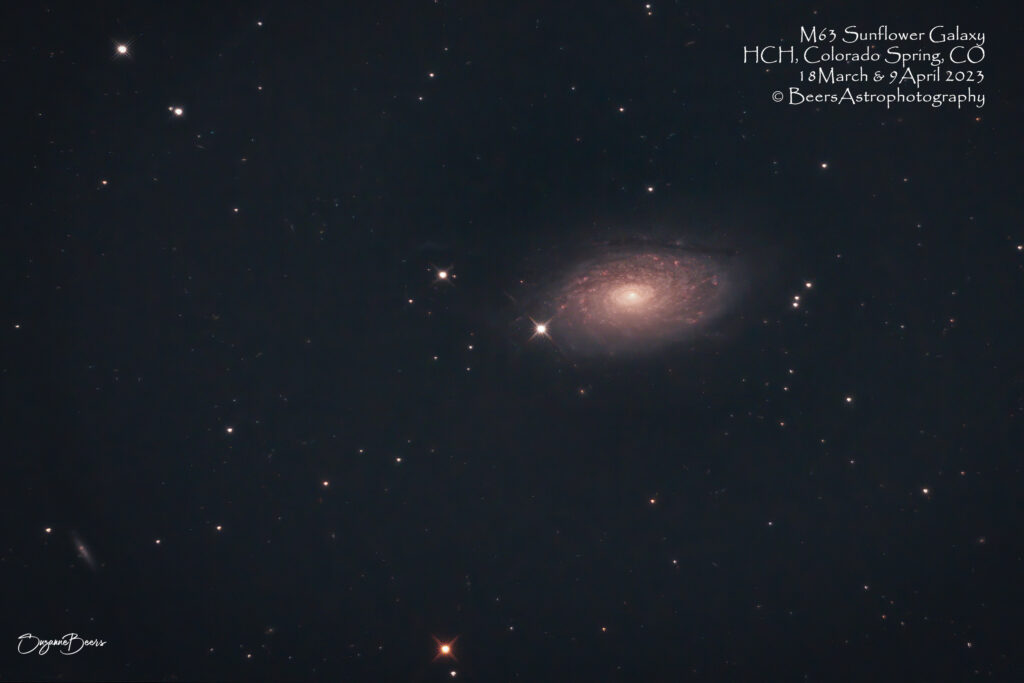
Fun facts
Messier 63 or M63, also known as NGC 5055 or the seldom-used Sunflower Galaxy, is a spiral galaxy in the northern constellation of Canes Venatici with approximately 400 billion stars. M63 was first discovered by the French astronomer Pierre Méchain, then later verified by his colleague Charles Messier on June 14, 1779. The galaxy became listed as object 63 in the Messier Catalogue. In the mid-19th century, Anglo-Irish astronomer Lord Rosse identified spiral structures within the galaxy, making this one of the first galaxies in which such structure was identified.
The shape or morphology of this galaxy has a classification of SAbc, indicating a spiral form with no central bar feature (SA) and moderate to loosely wound arms (bc). There is a general lack of large-scale continuous spiral structure in visible light, so it is considered a flocculent galaxy. However, when observed in the near infrared, a symmetric, two-arm structure is seen. Each arm wraps 150° around the galaxy and extends out to 13,000 light-years (4,000 parsecs) from the nucleus.
The distance to M63, based upon the luminosity-distance measurement is 29,300,000 light-years (8.99 megaparsecs). M63 is part of the M51 Group, a group of galaxies that also includes M51 (the ‘Whirlpool Galaxy’).
Other Catalog Designations: M63, NGC 5055, PGC 46153, UGC 8334
Subtype: Spiral Galaxy (Flocculent Galaxy)
Distance from Earth: 29 million light years
Size: 33,000 light years (radius)
Constellation: Andromeda
{ From: https://en.wikipedia.org/wiki/Messier_63 }
Capture Notes
We had cancelled our March 2023 dark skies trip due to snow and cloud cover. I thought that I had successfully set up my second control laptop (DSO-CTRL2), so, I boldly set up to shoot with two set-ups: Canon EOS Ra on Big Zeus (M81/M82 Bodes and Cigar; M63 Sunflower Galaxy) and ASI2400 on the Southern Cross (IC1848 Soul Nebula, Markarians Chain, IC4592 Blue Horsehead Nebula). After our St Patrick’s Day dinner guests left at about 2100MDT, I started the process with DSO-CTRL2 using ASI2400SC attempting to image IC1848. Experienced numerous issues, that I originally attributed to bad equipment setup within SGP. The sequence/set-up terminator was the fact that PHD would not calibrate – it was simply not moving and after ~30+ steps I got an error saying “star did not move enough” – which was a painful statement of the obvious! I finally gave up on DSO-CTRL2, moved ASI2400 to Big Zeus, brought out DSO-CTRL1, built a new sequence for M63 Sunflower Galaxy…all outside on the front patio, in the dark and about 15 degrees. After several attempts of plate solving and PHD calibration (with errors saying that it made too few steps and the accuracy was in question, I captured first image at 0006MDT. I let it run until the meridian flip (pretty bad tracking accuracy throughout the session) at 0225MDT. At that point, I captured flats and dark flats on that setup, then switched the camera and laptop to the Southern Cross to capture IC4592 the rest of the night…which turned out to be a bust.
The second night’s data (9 April 2023) was captured after waking at 0100 and deciding to switch from NGC2403 before it “hit” the house roofline to M63 Sunflower. I struggled mightily with the plate solving and autoguiding. Finally got the sequence going, by increasing the binning on the autoguider to 2×2. (Not sure if it was the moonlight messing with the autoguide camera – it did not look like there were any clouds, but the contrast was terrible and the “select several stars” was not working – only selecting on relatively dim star).
Equipment
Polar alignment: QHYCCD camera (controlled by Polemaster)
Imaging stream: Orion 10″ f/8 Ritchey-Chretien Astrograph Telescope, ZWO ASI2400MC imaging camera with Optolong L-eXtreme LP filter.
Mount: Sky-Watcher EQ6-R Pro Equatorial Mount (controlled by EQMOD)
Autoguider: Orion 60mm Multi-Use Guide Scope, Orion StarShoot AutoGuider Pro Mono Astrophotography Camera (controlled by PHD2)
Equipment controlled by HP Probook (DSO CTRL 1) running Sequence Generator Pro v3.2.0.660.
Capture & processing notes
Sequence plan(s):
18Mar2023: Gain: 158, Temp: -0°C, offset not set. BZ LPro 29x5min. Captured 19Mar2023 0001MDT – 0231. Total exposure time: 2:25hrs.
9Apr2023: Gain: 158, Temp: -0°C, offset=30. BZ LeX 15x10min. Captured 10Apr2023, 0145MDT – 10Apr2023, 0417MDT. Total exposure time: 2:30hrs
Capture: 18 March 2023 & 9 April 2023
Shooting location: Colorado Springs, Colorado
Processing: Stacked in APP, processed in LR/PS.
